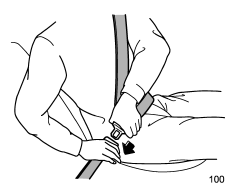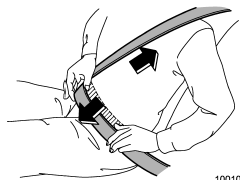Front seatbelts
1. Adjust the seat position:
Driver’s seat: Adjust the seatback to the upright position. Move the seat as far from the steering wheel as practical while still maintaining full vehicle control. Front passenger’s seat: Adjust the seatback to the upright position. Move the seat as far back as possible.
2. Sit well back in the seat.
3. Pick up the tongue plate and pull the belt out slowly. Do not let it get twisted. If the belt stops before reaching the buckle, return the belt slightly and pull it out more slowly. If the belt still cannot be unlocked, let the belt retract slightly after giving it a strong pull, then pull it out slowly again.

4. Insert the tongue plate into the buckle until you hear a click.

5. To make the lap part tight, pull up on the shoulder belt.
6. Place the lap belt as low as possible on your hips, not on your waist.
See also:
To open the moonroof
Pull the switch to the “OPEN” side and
quickly release it to open the moonroof.
The sun shade will also be opened
together with the moonroof. The moonroof
will stop at a position 20 in (50 cm) ...
To open and close the trunk lid from outside
The trunk lid can be opened using the remote keyless entry system. Refer to “Opening
the trunk lid (Legacy)” F2-9.
To close the trunk lid, lightly press the trunk lid down until the latch engages.
...
Tech Features
The optional navigation system includes a large screen with excellent
graphics and plenty of street labels, but some simple actions — canceling route
guidance, for instance — require an excessive ...


